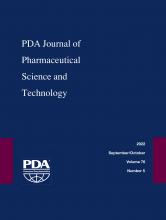Abstract
Liquid-in-vial drug products are typically overfilled to meet the label claim volume specification while taking into account losses in the container-closure system and withdrawal device. Any overfill volume setting requires justification. The aim of this study was to estimate the overfill volume required for a liquid drug product in a vial using a prediction model. Glass vials sized from 2R to 20R capacity were filled with sorbitol-based aqueous solutions having a viscosity at 20°C ranging from 1 to 40 mPa·s. Viscosity and vial neck diameter were shown to be the main contributors to the hold-up volume of sorbitol-based aqueous solutions in vial and withdrawal syringe. The hold-up volume of various molecules of therapeutic interest was successfully estimated using a model built from sorbitol-based aqueous solutions data. A total variability approach is proposed for estimating the overfill volume of liquid-in-vial drug products, taking into account the product hold-up volume in vial and withdrawal syringe, the filling variability, and the extractable volume test variability. This prediction model could provide a first guess of the fill volume range to be tested to support overfill volume definition.
- © PDA, Inc. 2022
PDA members receive access to all articles published in the current year and previous volume year. Institutional subscribers received access to all content. Log in below to receive access to this article if you are either of these.
If you are neither or you are a PDA member trying to access an article outside of your membership license, then you must purchase access to this article (below). If you do not have a username or password for JPST, you will be required to create an account prior to purchasing.
Full issue PDFs are for PDA members only.
Note to pda.org users
The PDA and PDA bookstore websites (www.pda.org and www.pda.org/bookstore) are separate websites from the PDA JPST website. When you first join PDA, your initial UserID and Password are sent to HighWirePress to create your PDA JPST account. Subsequent UserrID and Password changes required at the PDA websites will not pass on to PDA JPST and vice versa. If you forget your PDA JPST UserID and/or Password, you can request help to retrieve UserID and reset Password below.






